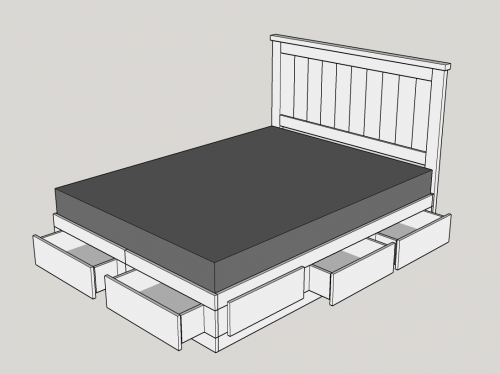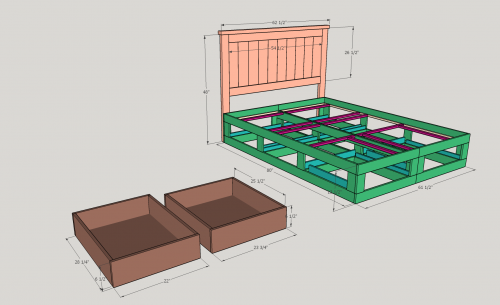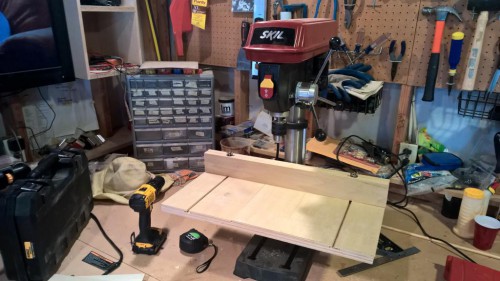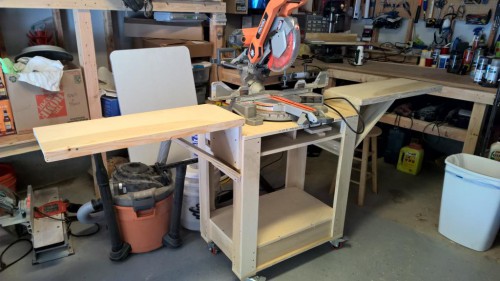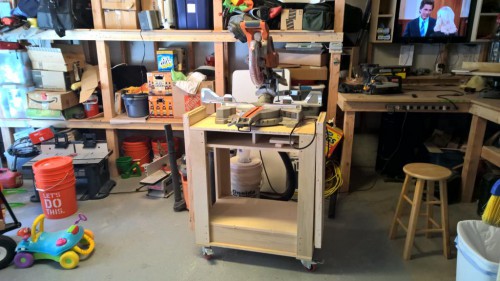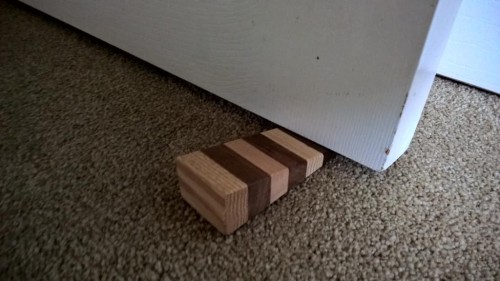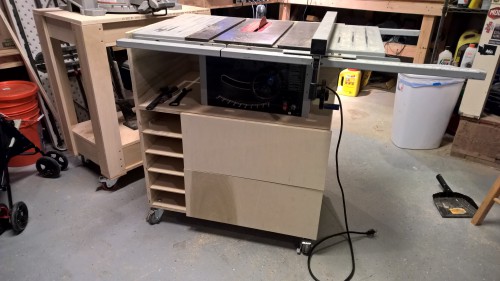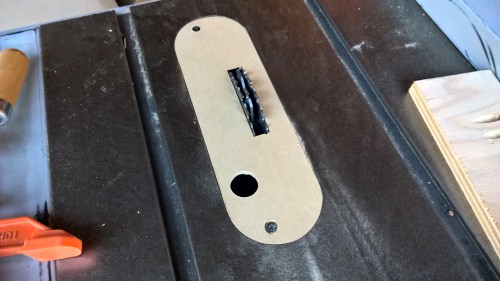 A recent thread on the woodworkers discussion list at work mentioned craftsy.com. As the name implies, it’s a craft site that provides lessons, kits and supplies. The part that specifically interested me was woodworking, but they also cover quilting, sewing, cooking, knitting, photography and more. A lot of the videos will cost you some money to watch, but there are a few free selections as well. The free woodworking videos include on one finishing (which I’m not very good at) and setting up a band saw (which I hope to purchase soon) so I plan to watch them. Yes, you can probably find similar stuff on YouTube for free, but if this site lives up to the promise then these should be more in depth and higher quality to justify the price.
A recent thread on the woodworkers discussion list at work mentioned craftsy.com. As the name implies, it’s a craft site that provides lessons, kits and supplies. The part that specifically interested me was woodworking, but they also cover quilting, sewing, cooking, knitting, photography and more. A lot of the videos will cost you some money to watch, but there are a few free selections as well. The free woodworking videos include on one finishing (which I’m not very good at) and setting up a band saw (which I hope to purchase soon) so I plan to watch them. Yes, you can probably find similar stuff on YouTube for free, but if this site lives up to the promise then these should be more in depth and higher quality to justify the price.
Crosscut Hardwoods
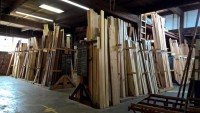 I love the early phases of a new hobby because there’s so much to explore. As I’ve started learning about working with nicer wood, I’ve heard lots of people talking about Crosscut Hardwoods in Seattle. Elijah and I took a trip over there last weekend and my mind was blown.
I love the early phases of a new hobby because there’s so much to explore. As I’ve started learning about working with nicer wood, I’ve heard lots of people talking about Crosscut Hardwoods in Seattle. Elijah and I took a trip over there last weekend and my mind was blown.
It’s an unassuming building in the industrial district south of the stadiums. Walk in and you find a few huge rooms with more woods than you knew existed. Want some Honduran Rosewood? They have that. How about Fiji Mahogany or Port Orford Cedar? Got that too. You can see the full list on their site.
But they don’t just have lots of wood, they have it in a huge variety of sizes. You can get it milled different ways at really big lengths (20+ feet!) Once you’ve decided what you want, you pay for it and then they will cut it up a bit so that you can transport it.
They have lots more in addition to hardwoods including a big selection of specialty plywoods, flooring and countertops.
I was only there for a recon mission but I scooped up some interesting looking offcuts from their “pay by the pound” pile. To make really good use of this store, I really need to get a band saw and a thickness planer so that I can mill the wood into the exact size that I need for a project.
Guest Room Bed
The bed in our guest room consists of a mattress on a box spring on a very simple metal frame. I decided it was finally time to build something a little nicer and give us more storage in the process.
The design is based very heavily on Steve Ramsey’s platform bed. I decided to redraw it from scratch in Sketchup to get some more experience using the app and also to scale it down from a king size to a queen size bed. Tim built a similar bed recently from a different design so I was able to use (hopefully) some of the things he learned along the way.
This design process went much better than my previous attempts with Sketchup and this time I feel like it was actually a valuable use of my time. I’ve included a couple screenshots of the complete design roughly showing the colors that it will actually be and then a view of the guts of it color coded to help differentiate things a bit. (The second drawing doesn’t include all of the slats that will run across the top to support the mattress.)
The design is based mostly on 1x4s with a few exceptions. This should keep it light (and cheap). Most of it is held together with pocket screws. Almost the entire underside of the bed is used for drawers. Some of them won’t pull out all the way and the ones by the head of the bed will be difficult to access, but why not make them full size?
I’ll paint it white when I’m done so I’m just using simple pine boards from Home Depot. We’ll see how long this takes me to complete. Again, there are a lot of firsts for me on this project which usually equates to me making multiple attempts at some steps.
Drill Press Table
If a tool isn’t convenient to use, it’s tempting to find a way to skip using it. That’s the case with my drill press. Often I only need to make one or two holes with it and rather than drag it out from under the bench, I just use a hand drill. To make this a more useful part of the process, I created a table for it.
The design comes from one of Steve Ramsey’s older videos, and he got the design from a magazine. You only need a few scraps of wood to build it and it has a lot of great features. A couple toilet bolts slide into the T-track and go up through the fence to make the fence easily adjustable (or removable). The piece of wood directly under the drill bit slides out and is replaceable so after it gets beat up, you can just slide a new one in.
I built this in an afternoon and I’m really happy with how it turned out. The only change I’d made if I was redoing this would be to make the T-track narrower so that the toilet bolt head couldn’t spin in the track. That would make it easier to tighten the nuts on top.
I’ve found a spot for this on my bench so we’ll see if I’m able to save some time and use it in more projects.
Miter Saw Cart
I’ve had my 10″ Ridgid sliding miter saw sitting on a cart for quite a while. With my smallish work area, it’s nice to be able to roll it around. The cart was originally built mainly as an outfeed table for my table saw, but I rarely used it that way. While the miter saw fit well on the cart, it was tricky to cut longer boards because I had no good way to prop up the ends.
One of Jay Bates’s earlier videos (before he got better at editing them) showed some foldable arms that he built for his miter saw cart. It seemed like an easy solution and I was able to build it with scraps leftover from the table saw stand.
You can pretty much see the entire design by looking at the pictures below. There’s not much to it. The hinge points are just Kreg screws that are normally used for pocket holes. Since they are only threaded halfway, it makes an easy hinge point.
The trick is whether or not they will last a long time. I already had one part split as I was putting it together, and of course, as I showed it off to Don, the arm snapped off. I rebuilt that part a little better the next day and now everything folds pretty nicely. I don’t have a whole lot of time or money in these so even if they only last for a few projects, I’ll be happy (and most likely they’ll last longer than my desire to have the saw on this cart.)
Door Stops
We have central air conditioning in our house, but we prefer to leave the windows open instead when possible. That means we end up with various shoes, books, and hampers sitting in front of each door upstairs to keep it propped open. On Sunday evening, I was looking for a quick and easy project to build without any planning so I decided to build some door stops.
I glued together a bunch of scrap wood, used the table saw to trim it up and then the miter saw to cut the wedges. A couple coats of spray lacquer finished off the job.
This was a super simple project, but it makes me happy when I see them sitting under the doors upstairs. They look nicer than the random objects we used before, and each piece of wood that I used in the doorstops brings back memories of other fun projects. It was rewarding to walk into the shop for an hour or two with no plans and walk out with a finished project.
Table Saw Stand
My table saw came from Tim who got it from Doug. I think Doug put together the rolling base for the metal stand. It worked ok, but the wheels were a bit small when I’d try to roll it out into the driveway and my first attempt at dust collection for the table saw never worked that well. I decided to build a new stand from scratch and I took the opportunity to learn some new things along the way.
The first task was to really learn SketchUp. It’s a free 3D modeling tool that is especially popular among woodworkers. As with any tool like this, there is a steep learning curve, but I’ve seen how much it can help people once they get the hang of it. I’m far from an expert but it was handy to visualize the build before getting into it, and it also helped me figure out how much wood I needed to buy. (The colors are just to help differentiate the pieces.) I stopped tweaking the drawing once I got it close and then I modified all the measurements slightly in my head so that I could make better use of the plywood and not have so much waste. Next time, I’ll spend the extra time to make those tweaks in the model because it would be really helpful to take measurements right from the model to figure out where all the dadoes go.
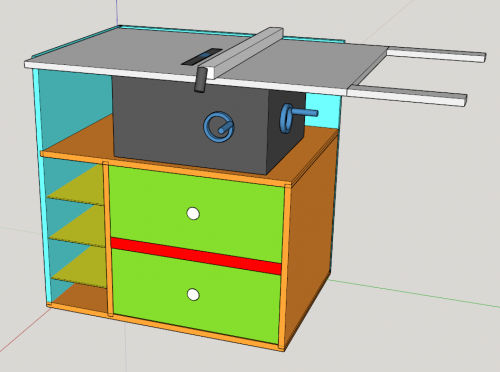 The next thing I learned was using a dado stack on the table saw. I cut lots of dadoes for Tyla’s jewelry box, but I used the router table for all of those. Tim loaned me his dado blades and I used my new custom insert. That setup combined with the track for cutting plywood made quick work of the main pieces
The next thing I learned was using a dado stack on the table saw. I cut lots of dadoes for Tyla’s jewelry box, but I used the router table for all of those. Tim loaned me his dado blades and I used my new custom insert. That setup combined with the track for cutting plywood made quick work of the main pieces
The dadoes made it easy to hold everything in place while I glued and nailed it together. Unfortunately, once I was part way into the assembly, I realized that I had cut one dado 1/2″ off of where it was supposed to be. Also the whole unit wasn’t quite square. The result was that it looked a little goofy and the box that was going to hold the two shelves wasn’t square. Yuck.
I ended up working around the mess. You can easily tell that it was built by a novice, but it functions quite well. There’s a hole cut out under the table saw so the dust falls into the top drawer. Plus, I have lots of storage for push sticks, blades, and jigs.
I put tall sides on the left and the back thinking that I might add some flip up tables on those sides to help support bigger pieces of wood. I’m not sure if/when I’ll get to that, but it was an easy addition to the project in case I decide to do that later.
The whole unit is solid and rolls around very nicely. The wheels are salvaged from my old Park ‘N Move which I don’t need after selling the motorcycle.
I’d be happy to toss this whole thing out for a nicer table saw, but in reality, this saw has been good to me and I think I’m going to have it for quite a while. There are lots of other tools I’d rather have before a new table saw.
PS. I also should have done a better job planning my cuts so that I could have matched the grain on the drawer fronts. I ended up with a huge green blotch in the poplar plywood on that bottom drawer and it very obviously doesn’t match the top drawer.
Table Saw Insert
I never paid much attention to the insert that fits around the blade in my table saw until I tried to install a thick dado set of blades and they didn’t fit into the insert. You can pay $30-50 and buy new ones but yikes, that’s pricey for just the few cuts I wanted to make.
Instead, I pulled out a scrap piece of wood, cut out the exact shape of the opening, cut out a finger hole, drill some screw holes, routed the bottom to make it the right thickness and then mounted it into the table. I clamped a piece of wood over the insert to hold it down and then turned on the blade. I slowly raised the spinning blade up and it cut a perfectly sized hole in the insert. Booyah. Custom table saw insert for free!
You can find lots of great videos on YouTube showing you how to do this but I particularly liked the one from Frank Howarth.
Cutting Plywood
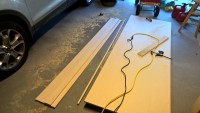 I usually work alone in the garage so cutting big sheets of plywood or MDF can be a hassle. Running it across the table saw just isn’t an option until I’m dealing with smaller pieces. In the past, I’ve picked out a straight 2×4, clamped it to the plywood, and then used that as a guide for the circular saw. That works pretty well but it can take a long time to get the guide set up in just the right spot.
I usually work alone in the garage so cutting big sheets of plywood or MDF can be a hassle. Running it across the table saw just isn’t an option until I’m dealing with smaller pieces. In the past, I’ve picked out a straight 2×4, clamped it to the plywood, and then used that as a guide for the circular saw. That works pretty well but it can take a long time to get the guide set up in just the right spot.
I finally got around to making a jig to help with this. It’s not complicated and I definitely didn’t invent the idea, but here’s how you make it:
1) Cut off a 3″ by 8 foot slice of your sheet of plywood. Make sure that you’re keeping a factory edge and you mark it. That’s your straight edge.
2) Measure the distance between your circular saw edge and the blade. Add 3″ for your cutoff and then another ~3″ for clamp room. Cut off another slice that wide. That will be the base of your jig.
3) Glue the 3″ strip on top of your base strip. Make sure the factory edge is pointing at the wider side of the base strip. It should be about 2″ from one edge. Add nails to hold it in place while the glue dries.
4) Now make a cut with your circular saw to trim off the extra wood.
You now have a zero-clearance jig to help you rip plywood. If you’re making a cut on the plywood, add a pencial mark on each end of the sheet where you want to cut. Then clamp your jig down so that it is right up against your pencil marks. Run your circular saw, holding it tightly up against the top fence and you’ll get nice straight cut in the right spot.
My typed-out description isn’t great, but there are lots of videos showing how it all works. I recommend Jay Bates’s blog post and video. He gets to it about halfway through the post/video.
The 8 foot length is a bit long when you’re doing 4′ cuts but we’ll see how it goes. Maybe I’ll end up making a second shorter one.
Milling Logs
YouTube is an incredible resource for learning a new hobby (or expanding the horizons of your current hobby.) Case in point: Matt Cremona. He doesn’t just go to the lumber yard to buy wood for his projects. He walks through the woods, cuts down a tree, slabs it with a chainsaw mill, lets it dry and then takes it into his shop to finish milling it for a project. While this isn’t something that I’ll probably ever get to do, it’s really fun to see how it works. Check out this video demonstrating his chainsaw mill:

